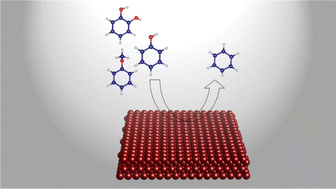The catalytic hydrogenolysis of compounds derived from guaiacol on the Cu (111) surface: mechanisms from DFT studies
Abstract
Pyrolysis oils have inferior properties compared to liquid hydrocarbon fuels, owing to the presence of oxygenated compounds such as guaiacol, C6H4(OH)(OCH3). The catalytic hydro-deoxygenation (HDO) of phenolic compounds derived from guaiacol, i.e. catechol, phenol and anisole were investigated over the Cu (111) surface to unravel the elementary steps involved in the process of bio-oil upgrade. The phenolic compounds adsorb through their π systems to the surface, where steric effects of the methoxy group reduce the stability of anisole on the surface. To produce benzene, hydroxyl removal from catechol and phenol occurs in a stepwise fashion, where dehydroxylation of catechol is more challenging than phenol. Thermodynamically, catechol is the preferred oxygenated product, but it is the most challenging to transform to benzene, requiring an energy barrier of 1.8 eV to be overcome, which is similar to the HDO of anisole with an activation energy of 1.7 eV but more difficult than the HDO of phenol with an activation energy of 1.2 eV. The rate limiting steps in the HDO reactions are catechol dehydroxylation, anisole demethoxylation and phenol dehydroxylation. Our results show that ortho substituents impede C–O bond cleavage, as seen for catechol, whereas in the absence of an ortho substituent –OH cleavage is easier than –OCH3 cleavage to form benzene.

- This article is part of the themed collection: Computational Modelling as a Tool in Catalytic Science


 Please wait while we load your content...
Please wait while we load your content...